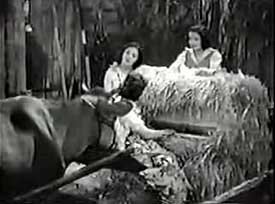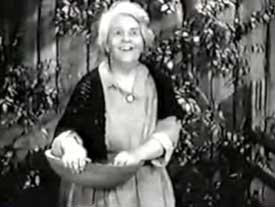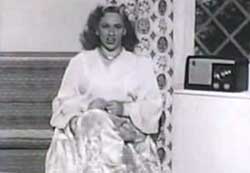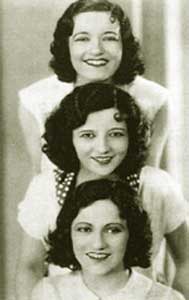 A one reel musical comedy Close Farmony (1932) is set "down on the farm." Old ma & pa just can't make ends meet with the amount of eggs the hens are laying. Pa reads in the paper that scientists have discovered the rhythms of jazz cause cows to give more milk & chickens to lay more eggs.
A one reel musical comedy Close Farmony (1932) is set "down on the farm." Old ma & pa just can't make ends meet with the amount of eggs the hens are laying. Pa reads in the paper that scientists have discovered the rhythms of jazz cause cows to give more milk & chickens to lay more eggs.
Quick as a wink, he's arranged for the Boswell Sisters to be sitting in the barn at a piano made of straw, singing: "Three Little Innocent Maids are We/ Fresh from the wicked city/ We never used to go bed till three/ Wasn't that a pity/
"We've given up the backstage life/ We're all to taking vows/ We are here to syncopate/ The chickens & the cows/ The very thought of being here has set our hearts a-flutter/ Our salary is two quarts of milk & pound of country butter/
"We're quittin the 'hey hey'/ We're hitten the hay/ We're givin' up the night life now/ The cows & the chickens want us to stay/ We're going to live the right life now." And so on.
 It's sweet syncopation, quite a lovely song despite its novelty cuteness. When the finish their number, Pa calls for Billy, & Billy Hughes climbs yawning out from under loose hay. Pa tells him it's time for him to play "Some of that jazz MOOzick of yours!" It's sweet syncopation, quite a lovely song despite its novelty cuteness. When the finish their number, Pa calls for Billy, & Billy Hughes climbs yawning out from under loose hay. Pa tells him it's time for him to play "Some of that jazz MOOzick of yours!"
He & the gals move the straw piano closer to the chickens. Billy belts it out to the chickens: "When you hear me syncopating/ Wa dah dah & poop-a-doo/ What time is it?/ Time to bill & coo."
He's not half as good as the Boswells, but few are, & he's very charming. As Connie Boswell plays a bit of ragtime on the straw piano & Billy sings, the eggs start coming one after another, & one of the egg's bigger than a goose egg.
The Boswells do another number, this one for the cows. "Milk, mmm milk, mmm, beautiful milk, bom bom bom bom/ Young ones cry for it/ Grown ups die for it/ Come on cow, moo-ooo/ Be a cutie now, do your duty now, give cow give..." while a happy cow watches them & chews its cud.
It's wonderful camp but it's so well sung that if the words hadn't been silly it could've been a jazz hit. They next sing "Red Hot Barnyard Rag" which isn't quite as campy, but a fantastic jazz piece for kids.
This is simply a great short subject & the Boswells, in their first film appearance, have a great sound. See them also as live-action & as animated characters in the Fleischer Studios sing-along cartoon When It's Sleep Town Down South (1932).
 Connee Boswell, the composing & arranging genius among the Boswell Sisters who were at their peak of popularity during the first half of the 1930s, was visited in her Manhattan apartment by the Snader Telescription filmmakers to record a couple of performances. One of these was Connee singing her 1937 hit Martha (1951), a "swinging" version of an opera libretto.
Connee Boswell, the composing & arranging genius among the Boswell Sisters who were at their peak of popularity during the first half of the 1930s, was visited in her Manhattan apartment by the Snader Telescription filmmakers to record a couple of performances. One of these was Connee singing her 1937 hit Martha (1951), a "swinging" version of an opera libretto.
After the Boswell Sisters retired (way too prematurely if you ask me) in 1936, Connee continued with a solo career. She had hit songs & regular radio guest stints through the 1940s, & television variety appearances in the 1950s. She was a great influence on Ella Fitzgerald. But I have to confess that I loved the Boswell Sisters harmonizing together while finding Connee by herself a mite less satisfying.
Showing up at her apartment for the filming was an unusual move since the three-minute Snader performances were shot on sound stages, usually quite rapidly one after another, & were not set up to film outside the studio. That they went this extra distance just to have Connee in their catalog of filmed performances is an indication of the esteem by which she was held.
Connee in long flouncy dress is shown in her apartment with her standard poodle Rebel. She's seated beside a radio, beside which Rebel joins her as she turns it on. In all performances with her sisters & later on her own, Connee was always shown seated, often at a piano, & Connee's legs never visible.
She was a victim of polio, though some references say "childhood accident." Connee never personally kept her condition secret & travelled openly with her wheelchair, but agents & producers always arranged for it to be unnoticeable in concerts & films, so that the general public never knew why she was never seen standing.
Band music swells from Connee's radio & she sings: "Oh so pure, Oh so bright/ Burst her beauty on my sight/ Oh so mild, so divine/ She beguiled this heart of mine/ Martha, Martha, Martha, Martha/ Thou has taken/ Every bliss away with thee/ Canst thou leave me thus forsake/ Come & share thy boon with me."
Connee was one of the first of the swing jazz singers to take standards like "Martha" that were old-fashioned even in the '30s & turned them into swing tunes. But Connee as a solo act had never been as exciting as with the Boswell Sisters. For this performance late in her career, Connee lacks the charisma of her youth, & the performance really isn't much more than nostalgia.
The orchestra coming from the radio is unidentified. The original had Connee singing with Bob Crosby & the Bobcats, & that 1937 recording was much more the thing. The telescription is intriguing just for being in Connee's home. And it's funny that as she bursts into song, Rebel goes & hides behind a chair, apparently not used to hearing his mistress singing.
Connee is seated in a big easy chair as she sings Nobody's Sweetheart (1952) with considerable verve, a vastly better-done number than Martha. Though copyrighted a year after Martha, all Connee's telescriptions were filmed in one day.
copyright © by Paghat the Ratgirl
|


 It's sweet syncopation, quite a lovely song despite its novelty cuteness. When the finish their number, Pa calls for Billy, & Billy Hughes climbs yawning out from under loose hay. Pa tells him it's time for him to play "Some of that jazz MOOzick of yours!"
It's sweet syncopation, quite a lovely song despite its novelty cuteness. When the finish their number, Pa calls for Billy, & Billy Hughes climbs yawning out from under loose hay. Pa tells him it's time for him to play "Some of that jazz MOOzick of yours!"